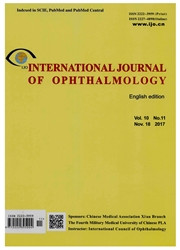

 中文摘要:
中文摘要:
AIM: To examine the relationship between angiogenesis and lymphangigenesis in recurrent pterygia. METHODS: Tissues from 34 excised recurrent pterygia (including 12 Grade 1, 10 Grade 2, and 12 Grade 3) were involved in the study and tissues from 7 nasal epibulbar conjunctivae segments were used as controls. Sections from each pterygium were immunostained with CD31 and LYVE-1 monoclonal antibodies to evaluate lymphatic microvessel density (LMVD) and blood microvessel density (BMVD), and the relationship between LMVD and BMVD in the pterygium was examined. RESULTS: There was a large number of CD31(+) LYVE-1(-) blood vessels but only a few CD31(+)LYVE-1(+) lymphatic vessels in grades 1 and 2 pterygium. However, lymphatic vessels were dramatically increased in grade 3 pterygium. LMVD correlated closely with BMVD in all pterygia, including grades 1, 2 and 3 peterygium patients(all P values 【0.01). Although both the density of blood and lymphatic vessels increased in recurrent pterygia, lymphatic vessels developed much faster than blood vessels, especially in grade 3 pterygia. CONCLUSION: There is a significant but not parallel relationship between angiogenesis and lymphangiogenesis in recurrent pterygium. The outgrowth of blood and lymphatic vessels provide evidence that immunological mechanism may play a role in the development and recurrence of pterygium.
 英文摘要:
英文摘要:
AIM: To examine the relationship between angiogenesis and lymphangigenesis in recurrent pterygia. METHODS: Tissues from 34 excised recurrent pterygia (including 12 Grade 1, 10 Grade 2, and 12 Grade 3) were involved in the study and tissues from 7 nasal epibulbar conjunctivae segments were used as controls. Sections from each pterygium were immunostained with CD31 and LYVE-1 monoclonal antibodies to evaluate lymphatic microvessel density (LMVD) and blood microvessel density (BMVD), and the relationship between LMVD and BMVD in the pterygium was examined. RESULTS: There was a large number of CD31(+) LYVE-1((-)) blood vessels but only a few CD31 (+)LYVE-1 ((+)) lymphatic vessels in grades 1 and 2 pterygium. However, lymphatic vessels were dramatically increased in grade 3 pterygium. LMVD correlated dosely with BMVD in all pterygia, including grades 1, 2 and 3 peterygium patients (all P values < 0.01). Although both the density of blood and lymphatic vessels increased in recurrent pterygia, lymphatic vessels developed much faster than blood vessels, especially in grade 3 pterygia. CONCLUSION: There is a significant but not parallel relationship between angiogenesis and lymphangiogenesis in recurrent pterygium. The outgrowth of blood and lymphatic vessels provide evidence that immunological mechanism may play a role in the development and recurrence of pterygium.
 同期刊论文项目
同期刊论文项目
 同项目期刊论文
同项目期刊论文
 期刊信息
期刊信息
